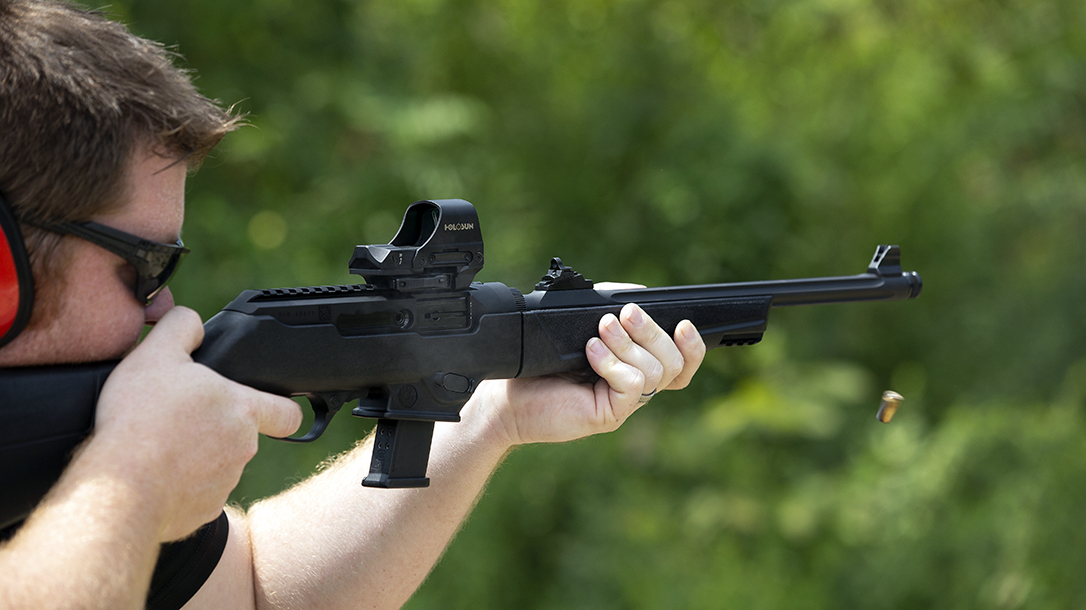

A short Picatinny accessory rail is molded into the front of the fore end. There is a rubber recoil pad and the length of pull is adjustable from 12.62 to 14.12 inches by means of three included 1/2" spacers. The molded, glass-filled, nylon synthetic stock is also black, with a textured grip. The barrel is threaded for use with standard muzzle accessories. There is an integral Picatinny rail atop the receiver, so you can easily add optics. It has an ambidextrous magazine release and charging handle. A clever takedown design allow the user to lock the bolt back, push a recessed lever, twist the sub-assemblies and pull them apart. The PC9 has an interchangeable magazine well, so you can use either Ruger or Glock magazines. The bolt is machined from heat treated, chrome-moly steel for strength, structural integrity and durability. The "dead blow" (blow-back) action features a custom tungsten dead blow weight that shortens bolt travel and reduces felt recoil and muzzle rise. The receiver is CNC-milled from 7075-T6 aluminum alloy and given a matte black anodized finish. The factory ghost ring iron sights are also quite good. The Ruger PC9 has a lot going for it and in brief test-firing I was pleasantly surprised at its good trigger, which uses 10/22 components. Now, for 2018, we have the Ruger PC9 Carbine. Apparently, Marlin got cold feet when the ban was enacted and stepped away from the market. The ill-fated, so called "Assault Weapons Ban" took effect in 1994 and expired in 2004. I let Mom use my Camp 9, as it was so comfortable to shoot. Somehow, he convinced my Mom to shoot with us in the rain and mud for that purpose. When my Dad and I shot at the Illinois State Rifle Association event, to qualify for the M1 Garands offered by the Civilian Marksmanship Program, Dad wanted two Garands. While standard capacity was 12 rounds, I used S&W Model 59 14 round magazines in mine. Several years back, the Marlin Camp 9 was reasonably popular and I used mine on groundhogs. Finish: Matte, type III hardcoat anodized.In addition, most people can shoot a carbine more accurately than the handgun, even at indoor distances. While this does not turn the 9mm Luger into a real rifle cartridge, it is a significant jump for home defense and 9mm makes a very pleasant round with which to plink. The Hornady 115 grain Critical Defense round jumps from 1140 fps to 1378 fps out of the Ruger PC9. Out of this Ruger carbine, the same round jumps to about 1430 fps.Ĭontingent on the specific cartridge, you are getting somewhere in the area of a 20% increase in muzzle velocity. With a four inch pistol and Cor-Bon JHP +P 125 grain rounds, you can expect a muzzle velocity (MV) around 1226 fps. The Ruger PC9 Carbine has a 16.12 inch heavy, fluted barrel and that can mean a big performance increase, compared to pistol exterior ballistics. For today's consumer, a 9mm semi-auto offers lower cost per shot than most centerfire rifle cartridges. 45 ACP rounds as the 1911 pistol that was standard issue from 1911 onward, simplified ammunition supply. Military from 1938-1971, with over 1.5 million produced during WWII. The Thompson M1928A1, the "Tommy Gun," was in service by the U.S. There is built-in appeal in the notion of being able to use the same ammunition in your rifle as in your pistol.

First Look: Ruger PC9 9x19mm Carbine By Randy Wakeman


 0 kommentar(er)
0 kommentar(er)
